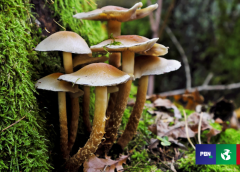
Why Mushrooms Are The Future Of Everything, From Sustainable Fashion To Food
[ad_1]
We’ve been eating mushrooms for thousands upon thousands of years.
Seriously: way (way, way) back in the Upper Paleolithic period, analysis of old dental calculus suggests the human diet included plant foods and mushrooms.
Since then, over the centuries, we’ve created countless recipes with all different types of mushrooms. There’s no doubt: portobello makes a mean burger filling, while button mushrooms are the perfect accompaniment for an English fry-up.
But in the last few years, innovators across industries, from food to fashion, have been looking at mushrooms in a whole new way. In fact, the fungus has so much potential and versatility, that it begs the question: are we entering the age of the mushroom?
Let’s start with how the humble fungi could transform the future of food for the better.
A sustainable, versatile ingredient
It’s no secret at this point: the food system needs some serious work. Right now, raising animals for meat is draining the earth of resources, emitting planet-heating gasses, and slaughtering billions of animals.
One of the worst offenders from animal agriculture is methane. The gas is more than 25 times as potent as carbon dioxide. Every year, just one cow burps 220 pounds of methane into the atmosphere.
But good news: mushrooms don’t belch. They don’t emit methane. And they can make a great plant-based steak alternative. British brand Quorn has known this for some time.
Founded in the 1980s, Quorn, which has partnerships with major chains like KFC, Greggs, and PizzaExpress, makes vegan and vegetarian meat products using mycoprotein. Aka fusarium venatum, mycoprotein is a type of fungus.
Through fermentation, Quorn creates a substance that has a very similar mouthfeel and texture to meat. But emits just a fraction of the emissions.
Other brands have caught on to the potential of mushrooms. Take The Mushroom Meat company, for example. It creates Porkless and Beefless Shreds and Patties, using gourmet mushrooms, upcycled plant proteins, and herbs and spices.
In fact, in 2020, the global mushroom market size was more than 14 million tonnes. By 2028, it’s set to grow at a compound annual growth rate of 6.74 percent. Fortune Business Insights names meat substitutes as a key driving factor of the market, “coupled with the rising vegan population.”
This is good news for the planet. Not only does harvesting fungi produce fewer emissions, but when mushrooms grow, they actually heal the environment.
Mushrooms help organic matter to decompose, for example, which returns valuable nutrients to the earth. They also absorb carbon. In 2013, one study found that fungi are responsible for most of the carbon sequestration in forests in northern Sweden.
The benefits of mushrooms don’t end with the environment. They’re also a favorite in the wellness world, known for improving mental and physical well-being. Andrew and Simon Salter, the founders of mushroom tea and coffee brand Dirtea, can attest to these benefits.
Wellness benefits
Back in 2016, the Salter brothers burned out from working nonstop and not sleeping enough. The mental fatigue was accompanied by physical issues too. “We were broken,” they told Plant Based News. “Tired skin, tired body, tired minds.”
They visited a GP, who gave them no “real cure,” they maintain, and desperation eventually led them to a London mushroom tea ceremony. The experience proved to them the wellness benefits of mushrooms and totally changed their lives. Later on, their mushroom beverage brand Dirtea was born.
“After our ceremony, we took these mushroom powders and committed to using them over the next couple of weeks to really feel the effects,” they said. “It wasn’t long before we both started to feel better. Our sleep was improved, stress and anxiety were under control, and we had more clarity than ever.”
Research backs up their experience: last year, one study (which involved more than 24,000 participants), linked mushroom consumption with a lower chance of anxiety or depression. The researchers put this down to their high content of antioxidants, which reduce oxidative stress and inflammation (depression risk factors).
“There are so many clinical studies which consistently show us how healing mushrooms are, and these simply cannot be ignored,” maintain the Salters.
The pair’s products include Lion’s Mane Mushroom Powder (lion’s mane is associated with several health benefits, including improved digestion and better brain function).
There’s also Reishi Mushroom Powder, Chaga Mushroom Powder, and Cordyceps Mushroom Powder. All can be drunk as teas, blended in smoothies, or mixed into coffee.
“Mushrooms are low in calories, carbohydrates, fat, and sodium,” the founders continue. “They’re also cholesterol-free and provide important nutrients, including selenium, potassium, riboflavin, niacin, vitamin D, proteins, and fiber.”
There’s no doubt that mushrooms benefit us and the planet when we eat them and drink them. But we can take it one step further: we can wear them too. And that comes with even more advantages, this time, for the animals and the rainforests too.
The rise of mushroom leather
From bags to shoes to belts, leather is used frequently across the fashion industry. But the process of making this material, which often comes from cows, is destructive to the environment and wildlife.
Last year, for example, an investigation linked several brands (including H&M, Adidas, Nike, Zara, and Fendi) to deforestation in the Amazon. This was because their leather supply chains have connections to JBS, a meat industry giant and the biggest leather exporter in Brazil.
The Amazon, which is the world’s largest tropical rainforest, is home to one in 10 known species on Earth, including critically endangered or threatened animals, like pink river dolphins and jaguars.
JBS is renowned for its role in Amazon deforestation (despite its commitments otherwise). It’s no surprise: cattle ranching (for the meat and leather industry) as a whole accounts for 80 percent of deforestation in the Amazon.
But leather production isn’t just bad for wildlife, it’s bad for farmed cows too. According to some predictions, by 2025, the leather industry will be slaughtering around 430 million cows every year.
But it doesn’t need to be this way. Because mushrooms can do the same job as cow-derived leather. Stella McCartney has proved it. In July of this year, the brand launched the first luxury bag made from Mylo leather by Bolt Threads. The material solutions company makes leather using mycelium, the root structure of mushrooms. In 2020, the designer label debuted a top and trousers, also made with Mylo.
Bolt Threads’ CEO Dan Widmaier said the collaboration was an “honor.”
“[Stella McCartney’s] category-defining leadership of animal-free fashion and championship of sustainable materials is paving a path forward towards a more responsible fashion industry,” he added. “Bringing the first-ever luxury bag made from Mylo to market is a massive milestone for conscientious consumers, the biomaterials industry, and the future of luxury fashion.”
Stella McCartney isn’t alone. In 2021, Hermès announced it had created a mushroom leather travel bag in collaboration with biomaterial company MycoWorks. In the same year, Adidas teamed up with Bolt Threads to launch a new Mylo range of its iconic Stan Smith sneakers.
By 2026, the bio-based leather market (which includes mushroom leather) is predicted to reach nearly $870 million in value. But many think it will keep climbing: mushroom leather is scalable, versatile, sustainable, and deforestation- and cruelty-free. It’s only a matter of time before it becomes the norm.
So give it a few years, and you could be sipping your mushroom tea, after you’ve demolished your mushroom steak, before unzipping your mushroom leather pants. It’s already happening: the age of fungi is upon us.
[ad_2]
Source link


